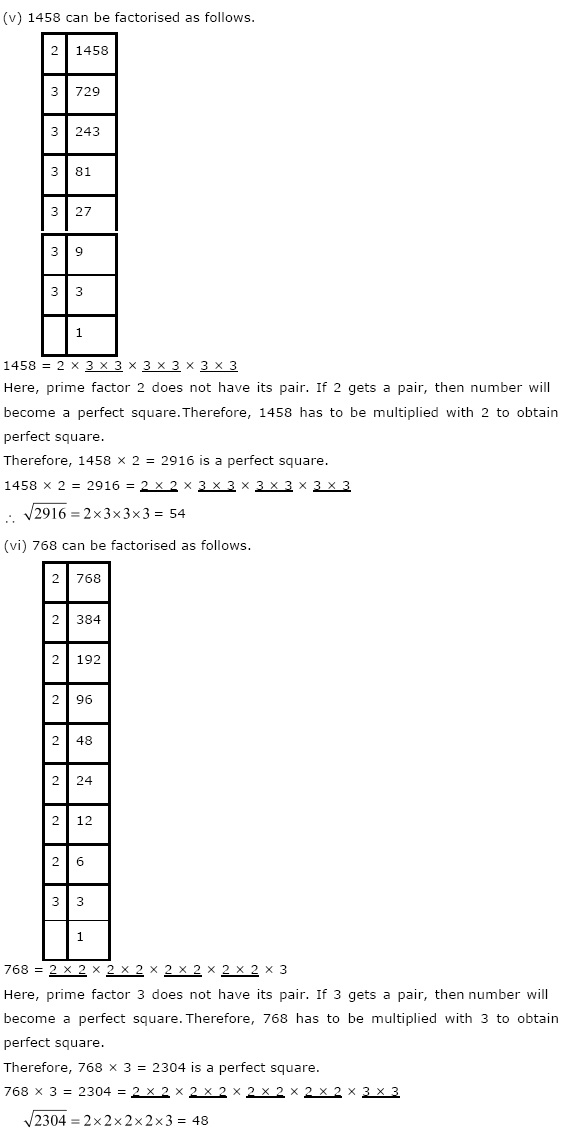NCERT Solutions For Class 8 Maths Chapter 6 Ex 6.3
ncert solutions for class 8 maths chapter 6, Exercise 6.3 involve complete answers for each question in the exercise 6.3. The solutions provide students a strategic methods to prepare for their exam. Class 8 Maths Chapter 8 Squares and Square Roots Exercise 6.3 questions and answers helps students to perform better in exam and it will clear doubts definitely. Students will find it extremely easy to understand the questions and learn solving the problems. NCERT Solutions for Class 8 Maths Chapter 8 Squares and Square Roots Exercise 6.3 prepared by our subject matter experts in very delicate, easy and creative way.
Question 1:
What could be the possible ‘one’s’ digits of the square root of
each of the following numbers?
(i) 9801 (ii) 99856 (iii) 998001 (iv)657666025
Answer:
(i) If the number ends with 1, then the one’s digit of the square
root of that number may be 1 or 9. Therefore, one’s digit of the square root of
9801 is either 1 or 9.
(ii) If the number ends with 6, then the one’s digit of the square
root of that number may be 4 or 6. Therefore, one’s digit of the square root of
99856 is either 4 or 6.
(iii) If the number ends with 1, then the one’s digit of the
square root of that number may be 1 or 9. Therefore, one’s digit of the square
root of 998001 is either 1 or 9.
(iv) If the number ends with 5, then the one’s digit of the square
root of that number will be 5. Therefore, the one’s digit of the square root of
657666025 is 5.
Question 2:
Without doing any calculation, find the numbers which are surely
not perfect squares.
(i) 153 (ii) 257 (iii) 408 (iv)441
Answer:
The perfect squares of a number can end with any of the digits 0,
1, 4, 5, 6, or 9 at unit’s place. Also, a perfect square will end with even
number of zeroes, if any.
(i) Since the number 153 has its unit’s place digit as 3, it is
not a perfect square.
(ii) Since the number 257 has its unit’s place digit as 7, it is
not a perfect square.
(iii) Since the number 408 has its unit’s place digit as 8, it is
not a perfect square.
(iv) Since the number 441 has its unit’s place digit as 1, it is a
perfect square.
Question 3:
Find the square roots of 100 and 169 by the method of repeated
subtraction.
Answer:
We know that the sum of the first n odd natural numbers is n2.
Consider √100.
(i) 100 − 1 = 99 (ii) 99 − 3 = 96 (iii) 96 − 5 = 91
(iv) 91 − 7 = 84 (v) 84 − 9 = 75 (vi) 75 − 11= 64
(vii) 64 − 13 = 51 (viii) 51 − 15 = 36 (ix) 36 − 17 = 19
(x) 19 − 19 = 0
We have subtracted successive odd numbers starting from 1 to 100,
and obtained 0 at 10th step.
Therefore, √100=10
The square root of 169 can be obtained by the method of repeated
subtraction as follows.
(i) 169 − 1 = 168
(ii) 168 − 3 = 165
(iii) 165 − 5 = 160
(iv) 160 − 7 = 153
(v) 153 − 9 = 144
(vi) 144 − 11 = 133
(vii) 133 − 13 = 120
(viii) 120 − 15 = 105
(ix) 105 − 17 = 88
(x) 88 − 19 = 69
(xi) 69 − 21 = 48
(xii) 48 − 23 = 25
(xiii)25 − 25 = 0
We have subtracted successive odd numbers starting from 1 to 169,
and obtained 0 at 13th step.
Therefore,
√169=13
Question 4:
Find the square roots of the following numbers by the Prime
Factorisation Method.
(i) 729 (ii) 400 (iii) 1764 (iv) 4096 (v) 7744 (vi) 9604 (vii)
5929 (viii) 9216 (ix) 529 (x) 8100
Answer:
(i) 729 can be factorised as follows.
Question 7:
Answer:
It is given that each student donated as many rupees as the number
of students of
the class. Number of students in the class will be the square root
of the amount
donated by the students of the class.
The total amount of donation is Rs 2401.
Number of students in the class = √2401
∴ √2401=7×7×7×7
√2401=7×7 =49
Hence, the number of students in the class is 49.
Question 8:
2025 plants are to be planted in a garden in such a way that each
row contains as many plants as the number of rows. Find the number of rows and
the number of plants in each row.
Answer:
It is given that in the garden, each row contains as many plants
as the number of rows.
Number of rows = Number of plants in each row
Total number of plants = Number of rows × Number of plants in each
row
Number of rows × Number of plants in each row = 2025
(Number of rows)2 = 2025
∴ √2025=3×3×3×3×5×5
√2025=3×3×5 =45
Thus, the number of rows and the number of plants in each row is
45.
Find the smallest square number that is divisible by each of the numbers 4, 9, and 10.
Answer:

















